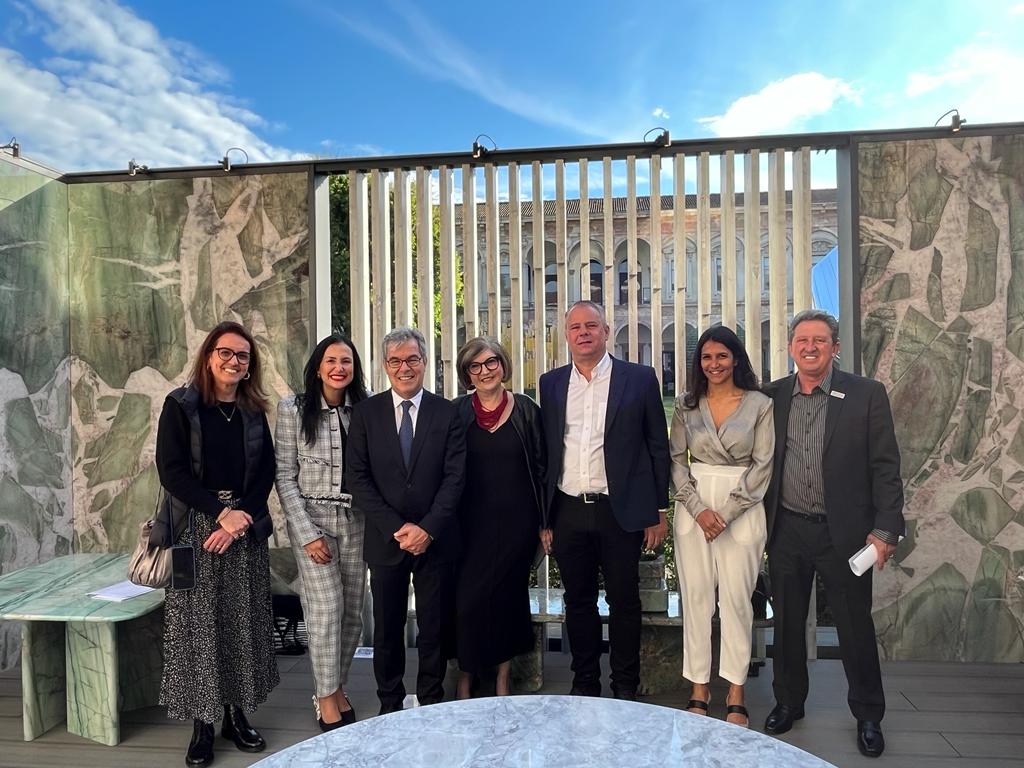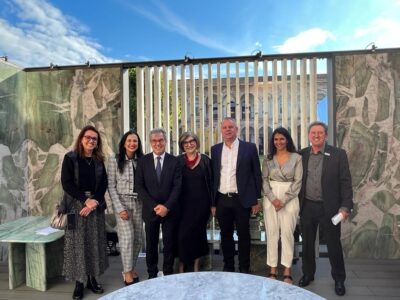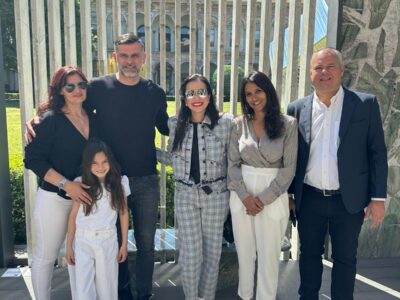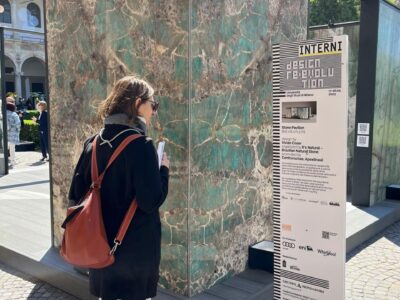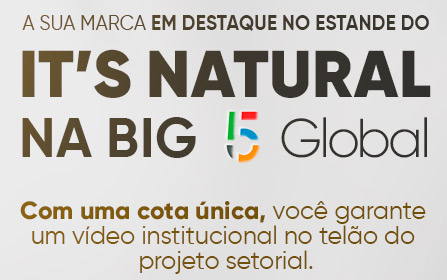Six companies from the Brazilian natural stone sector are participating in the Milano Design Week – FuoriSalone, in Italy, one of the largest design showcases in the world, which will be held at the Università degli Studi di Milano until April 26th as part of the Interni Design Re-Evolution exhibition.
In the Stone Pavilion, a design intervention, created by the architect and designer Vivian Coser, is composed exclusively of Brazilian stones – quartzite, semi-precious stone and dolomitic marble -, and builds the environment created by It’s Natural – Brazilian Natural Stone, a project to encourage exports of Brazilian ornamental stone promoted by the Brazilian Center of Ornamental Stone Exporters (Centrorochas) and the Brazilian Trade and Investment Promotion Agency (ApexBrasil).
Exhibiting slabs and design pieces, the natural materials from Cajugram, Dapaz, Decolores, Gramazini, Granistone, and Pedra do Frade, compose the environment planned under the essence of biophilia, a concept that takes the natural environment to urban spaces, promotes well-being, emotional comfort, and a sense of relaxation.
The president of ApexBrasil, Jorge Viana, and the manager of industry and services of the Agency, Maria Paula Velloso, visited the design intervention on the first day of the exhibition, accompanied by the president of Abimóvel, Irineu Munhoz, and the director, Cândida Cervieri. They were welcomed by Centrorochas general manager, Giovanni Francischetto, and by the architect Vivian Coser.
Sustainability
Owner of the greatest geological diversity in the world, Brazil has a large industrial park for the supply of blocks, finished and semi-finished products, works of art, design, and architecture, among others. Thanks to the technological capacity of production, the country has seen its rocks go through modern and environmentally sustainable processes.
More than 95% of all the water used in the production process is totally reused, besides, the production residues are used or destined to licensed deposits. The stones also have a lower CO2 emission rate in production, when compared to other coating options used in architectural projects.
Actively participating in the Green Building Council Brasil, Vivian Coser reinforces the sustainability of natural stone. “It does not contain any harmful chemicals or toxins. In addition, the material can be easily recycled and reused, which can extend its useful life, while preserving energy, water and other essential resources”, explained the architect who is also an ambassador for Instituto Terra (founded by photographer Sebastião Salgado and his wife Lélia Wanick Salgado, focused on sustainable practices and environmental recovery).
Commercial relation Brazil X Italy
Italy is currently the 3rd largest destination of Brazilian exports of natural stones. From this, 82,1% are blocks. The country’s preference for rough stones happens due to its large installed production capacity and the great know-how for processing and distribution of unique stones to Europe and the Middle East.
In 2022, Brazilian exports to Italy recorded revenues of U$ 103.4 million, 19.4% higher than 2021. “The determining factor for this growth was the increase in demand for high added value quartzite, materials that are applied in noble and exclusive environments, and that have been recording excellent commercial acceptance throughout Europe,” detailed Centrorochas’ general Manager, Giovanni Francischetto. “The performance of exports to the host country of the Milan Design Week, which until the year 2020 was stable (with sales averaging U$ 65 million per year), in 2021, registered a strong growth of 52.4% or U$ 19.7 million in the period and in 2022, exceeding U$ 100 million of Brazilian exported stones”, he explained.
Get to know the eight types of Brazilian stones on display
Amazonite (Supplied by Granistone)
An exotic semi-precious rock, made of quartz crystal, slat and a rare cyan colored pegmatite. It has a high degree of hardness and high resistance to acids and cleaning products. By having quartz in its composition, it can be backlit because it is translucent.
It can also be used in external areas, gourmet spaces, tables, bathrooms, pools, and furniture.
Apollo Light (Supplied by Cajugram)
The name Apollo was inspired by the sculptures of the Greek god of beauty, which seemed perfect for this quartzite. The material has light tones and soft veins that contrast with the quartz crystals, harmonizing easily in classic or modern settings with ease. It is a versatile stone that can be integrated into more traditional designs and bolder, more exotic projects. Its composition is 95% quartz crystals, which makes it a very dense material with a very homogeneous aspect, besides being hard, abrasion resistant, and with high resistance to compression and bending. The beauty of Apollo is mainly enhanced in its polished and satin finishes, and can be either applied indoors or in outdoor projects, for floors, walls, and countertops.
Da Vinci (Supplied by Decolores)
Da Vinci quartzite is a lush stone composed of mineral relics such as quartz and fuchsite, which give it a translucent appearance and green color. It features intriguing structures such as stratifications, smooth lines that depict how the quartz sands moved in the environment where Da Vinci was formed 3 million years ago. It can be used in a variety of areas, including swimming pools.
Natura (Supplied by Pedra do Frade)
Natura quartzite comes from a region called Serra da Carnaíba, where there is the largest concentration of emeralds in Brazil, which explains the emerald green color. It is composed of green quartzite, white quartz crystals, intertwined with fuchsite and emerald slag.
Lunar (Provided by Pedra do Frade)
Lunar is a dolomitic marble from southern Bahia, Brazil. This material has a white background with grayish veins, bringing elegance and versatility. Since it is a dolomite marble, it has above average resistance and can be used in many different projects, including kitchens.
Polaris (Supplied by Gramazini)
A peculiar quartzite with an intense green and white color. This one stands out in the market, intriguing with its beauty and durability. Polaris is the brightest star in the constellation Ursa Minor and is located approximately at the north celestial pole. This is why it is called Polaris. With its color variations from green to white and gold, a new “star” was discovered, Polaris.
Speranza (Supplied by Granistone)
A unique quartzite with a dark green background and neon green moving veins, it has a high degree of hardness and resistance to acids and cleaning products. It can be used in indoor and outdoor areas.
Vanilla Sky (Supplied by Dapaz)
Vanilla Sky is a golden, tan, and white quartzite from Brazil. Its timeless design can be adapted to almost any kind of project, from traditional to modern. This metamorphic stone is extracted in the mountains of Ceará, and its origins can be dated back hundreds of millions of years. Mother Nature imprints on this masterpiece soft movements that resemble brushwork with subtle movements that surprise without impressing the eye.
About It’s Natural – Brazilian Natural Stone
The It’s Natural – Brazilian Natural Stone is an export incentive program developed by the Brazilian Center of Natural Stones Exporters (Centrorochas) in partnership with the Brazilian Trade and Investment Promotion Agency (ApexBrasil). The program aims to stimulate and increase the exports of Brazilian natural stones, through a set of strategic actions for internationalization with promotional activities, strengthening the image and development of the sector in the market worldwide.
About Centrorochas
The Brazilian Center of Natural Stones Exporters acts directly on the procedures related to the presence of Brazilian businesspeople abroad combined with commercial and operational activities related to the development and evolution of Brazilian companies.
About ApexBrasil
ApexBrasil works to promote Brazilian products and services abroad and attract foreign investment to strategic sectors of the Brazilian economy. In order to achieve these objectives, the Agency carries out diversified trade promotion actions aiming at promoting exports and enhancing the value of Brazilian products and services abroad, such as prospective and trade missions, business rounds, supporting the participation of Brazilian companies in major international fairs, visits of foreign buyers and opinion leaders to be introduced to the Brazilian productive structure, among other business platforms that also aim at strengthening the Brazil brand.


